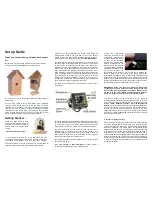
5 Mega-pixel Vandalproof IR PoE IP Camera
ICA-E5550V
56
IR Exposure Compensation
is available on all cameras with IR LEDs. This feature
automatically balances the IR exposure to eliminate over-exposed images cause by too much
IR on the subject. When enabled, the AE reference target is automatically adjusted to control
the sensor’s shutter speed and gain to compensate IR effect.
Exposure Mode -Auto
In Auto Exposure Mode, you control the image brightness by configuring the AE Reference
Target and Slowest Auto Shutter.
AE Reference Target
(Auto Exposure reference target) can be considered as the “Target
Brightness on Sensor”. The camera will use several internal parameters to achieve best quality
with reference to this.
The higher this value, the brighter the overall scene, however, there
may be more noise at night in such case.
The range of AE Reference Target is 1~255.
The camera will automatically control shutter speed, auto iris (if available) and signal gain to
achieve the target level set by the user. If the auto iris does not exist or is already opened to a
maximum size, and the image is still darker than the user defined target, it will further slow
down the shutter speed within the allowed range (set by user under Slowest Auto Shutter
Speed) and increase the signal gain.
Slowest Auto Shutter Speed
is the user defined threshold for slowest allowed speed of auto
shutter. For example, if by default the shutter speed would vary between 1/5s ~ 1/2000s
depending on the lighting conditions, then setting the Slowest Auto Shutter Speed to 1/30s
would narrow down the auto shutter range to work between 1/30s ~ 1/2000s. The purpose of
allowing user to define the threshold for slowest speed is to avoid motion blur caused by too
slow shutter at night.
It is also important to know that very high shutter speed is not recommended for indoor
solutions with artificial light that flashes with certain frequency, as it may produce flickering
effect, regardless of Exposure mode.
In extreme low light conditions, the shutter speed is slown down to get more light into one
image, but not slower than the user defined threshold.
If the exposure time extends beyond the interval between frames (too slow shutter), (i.e. 1/30
second), then the frame rate will be automatically reduced.
Longer time in this value gives
clearer images at night for slow moving objects, but more motion blur for fast moving
objects.
White balance
refers to the capability of the camera to understand what “true white color is”.
When the camera knows the true white color, then the rest of the colors will be accurate, too.
While human eye can easily adapt to different lighting sources (even mixed sources, such as
sun light through the window and indoor lights turned on at the same time), the camera has to
















































